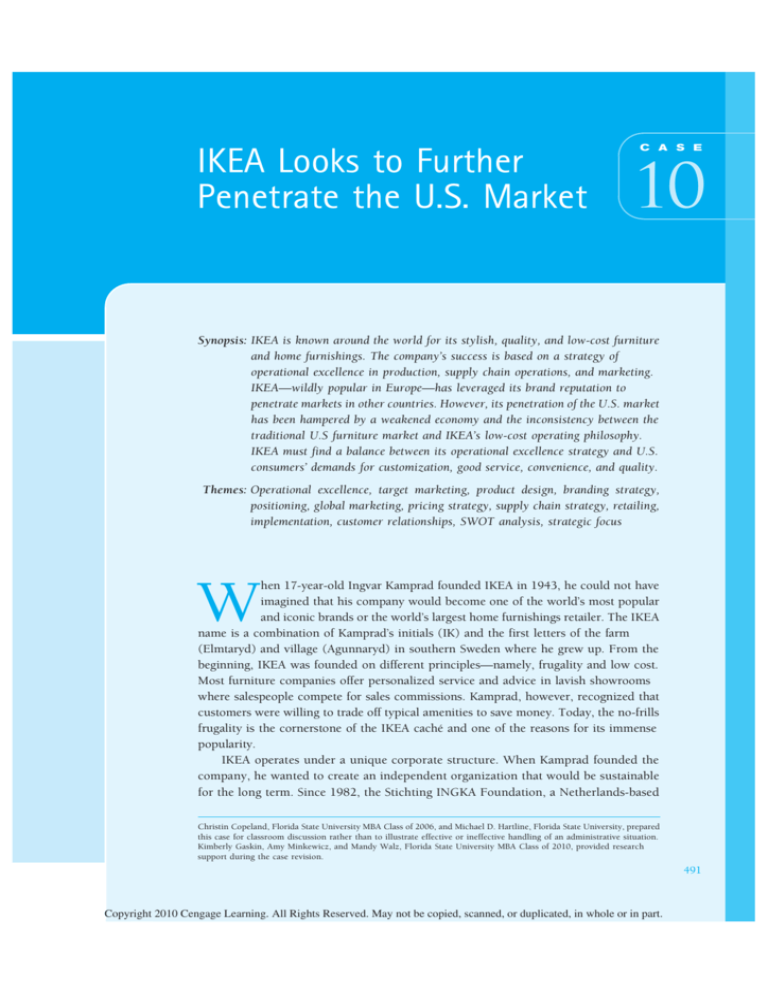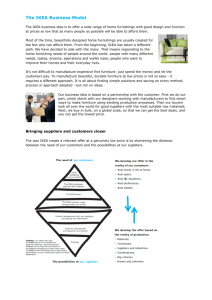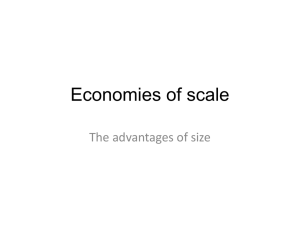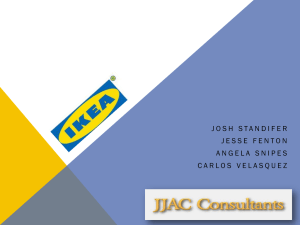
IKEA Looks to Further
Penetrate the U.S. Market
C A S E
10
Synopsis: IKEA is known around the world for its stylish, quality, and low-cost furniture
and home furnishings. The company’s success is based on a strategy of
operational excellence in production, supply chain operations, and marketing.
IKEA—wildly popular in Europe—has leveraged its brand reputation to
penetrate markets in other countries. However, its penetration of the U.S. market
has been hampered by a weakened economy and the inconsistency between the
traditional U.S furniture market and IKEA’s low-cost operating philosophy.
IKEA must find a balance between its operational excellence strategy and U.S.
consumers’ demands for customization, good service, convenience, and quality.
Themes: Operational excellence, target marketing, product design, branding strategy,
positioning, global marketing, pricing strategy, supply chain strategy, retailing,
implementation, customer relationships, SWOT analysis, strategic focus
W
hen 17-year-old Ingvar Kamprad founded IKEA in 1943, he could not have
imagined that his company would become one of the world’s most popular
and iconic brands or the world’s largest home furnishings retailer. The IKEA
name is a combination of Kamprad’s initials (IK) and the first letters of the farm
(Elmtaryd) and village (Agunnaryd) in southern Sweden where he grew up. From the
beginning, IKEA was founded on different principles—namely, frugality and low cost.
Most furniture companies offer personalized service and advice in lavish showrooms
where salespeople compete for sales commissions. Kamprad, however, recognized that
customers were willing to trade off typical amenities to save money. Today, the no-frills
frugality is the cornerstone of the IKEA caché and one of the reasons for its immense
popularity.
IKEA operates under a unique corporate structure. When Kamprad founded the
company, he wanted to create an independent organization that would be sustainable
for the long term. Since 1982, the Stichting INGKA Foundation, a Netherlands-based
Christin Copeland, Florida State University MBA Class of 2006, and Michael D. Hartline, Florida State University, prepared
this case for classroom discussion rather than to illustrate effective or ineffective handling of an administrative situation.
Kimberly Gaskin, Amy Minkewicz, and Mandy Walz, Florida State University MBA Class of 2010, provided research
support during the case revision.
491
Copyright 2010 Cengage Learning. All Rights Reserved. May not be copied, scanned, or duplicated, in whole or in part.
492
CASE
10
IKEA Looks to Further Penetrate the U.S. Market
charitable foundation, has owned the IKEA Group. Many estimates peg the foundation
as one of the world’s wealthiest charities—worth an estimated $36 billion. INGKA
Holding B.V., also based in the Netherlands, is the parent company for all IKEA Group
companies. The IKEA Group includes IKEA of Sweden (which designs and develops
all IKEA products), Swedwood (which makes all IKEA furniture), the sales companies
that operate IKEA stores, and all purchasing and supply chain functions. This type of
ownership is unique in that the foundation is a nonprofit organization designed to
promote innovation in architectural and interior design. Some criticize IKEA’s ownership as an arrangement that leverages the uniqueness of Dutch law to avoid taxes
and prevent a hostile takeover attempt.
Today, IKEA is Sweden’s best-known export. The company had 2009 worldwide
sales totaling $32 billion and an annual growth rate of 7 percent (down from 14
percent in 2008)—the company’s slowest growth rate in more than 10 years. Roughly
80 percent of IKEA’s sales come from operations in Europe, with North America and
Asia/Australia contributing 15 percent and 5 percent, respectively. The company has
123,000 employees (down more than 5,000 since 2008) and more than 301 IKEA
stores in 25 countries, with 267 of these stores belonging to the IKEA Group. The
remaining stores are owned and operated by franchisees. There are currently 36 U.S.
stores, with plans to open two more. IKEA had originally planned to have 50 stores
operating in the United States by 2010, but the recent worldwide economic recession
slowed IKEA’s plans. Worldwide, the company plans to open 26 additional stores
within the next year.
The IKEA Concept
The backbone of IKEA’s success is ‘‘The IKEA Concept.’’ IKEA’s vision statement
reflects this core operating philosophy:
Our vision is to create a better everyday life for the many people. Our business
idea is to offer a wide range of well-designed, functional, home furnishing
products at prices so low that as many people as possible can afford them.
To fulfill its vision, IKEA provides stylish, functional, low-cost home furnishings
that customers must assemble themselves. Furniture products are shipped in flat packs
to save money on manufacturing and distribution, which IKEA then passes on to
customers in the form of lower prices at retail. To compensate for the customer having
to ‘‘do it yourself,’’ IKEA offers other services that make this proposition a little more
attractive. These extra services include in-store child-care and play areas, restaurants,
and longer store hours. To help visitors prepare for this experience, IKEA provides its
customers with pencils, paper, tape measures, store guides, catalogs, strollers, and
shopping bags. IKEA even offers delivery for the bulky items that customers cannot
carry themselves. For those who want to carry their own bulky furniture home, IKEA
rents car racks for convenience. IKEA stores are designed as a circle so that everything
can be seen no matter in what direction the customer is headed. The aisles are wide to
Copyright 2010 Cengage Learning. All Rights Reserved. May not be copied, scanned, or duplicated, in whole or in part.
The IKEA Concept
reduce traffic congestion that could occur when customers stop to look at different
showrooms and displays.
Production
IKEA’s key objective regarding production is to establish and maintain long-term
supplier relationships. When designing new products, IKEA actually begins with a
target retail price in mind, and then works with roughly 1,400 suppliers in fifty-four
countries to find the lowest cost way to manufacture that product. Its oldest suppliers
are Swedish; however, other major suppliers are located in China (21 percent), Poland
(17 percent), Italy (8 percent), and Germany (6 percent). IKEA accounts for up to 10
percent of the furniture market in each country where its products are manufactured.
One strategy that IKEA has implemented is to place 41 trading offices in 30
countries around the world to localize its operations. This gives IKEA leverage to
increase production capacity (that is, labor hours and purchasing materials) when
needed. The strategy also allows IKEA to closely monitor manufacturing performance.
Producing high-quality products at the lowest possible cost drives IKEA’s production
mentality. In addition to local trading offices, IKEA also manages production through
long-term contractual relationships based on bulk buying. Committing to high-volume
purchases over a longer time frame allows IKEA to dramatically cut costs. Additionally, IKEA is in a position to offer its suppliers financial assistance if necessary. This
optimization is key to achieving the low-cost business model that IKEA wants to
maintain.
Cost consciousness dominates all aspects of IKEA’s operations. In land acquisition, IKEA locates stores on property just outside of target cities. In production, the
remnants of fabric and wood used for products are used to create more products. IKEA
uses natural colors to cut production costs and increase social responsibility to the
environment through the manufacturing process. Across its 27 distribution centers in
16 countries, flat packages are used to efficiently transport the large bulk of products
from suppliers to IKEA stores. The use of flat packages lowers warehousing and
distribution costs and the environmental impact throughout the supply chain.
Marketing
IKEA’s marketing program has four focal areas: product design, catalogs, advertising,
and public relations/promotions. IKEA’s product designs are arguably the most important part of its brand image. Customers love the clean lines, frugal styling, and
caché that ownership affords. IKEA admits that creating stylish and inexpensive
products is a challenging task. To fulfill its vision, the company’s full-time and freelance designers work closely with in-house production teams to pair the appropriate
materials with the least costly suppliers. Though the work is tedious, IKEA is wellknown for its product innovation.
IKEA’s main marketing focus is its printed catalog, where the company spends the
majority of its annual marketing budget. The 376-page catalog is produced in 52
different editions in 27 languages. In 2008, 200 million copies were put into circulation. The online catalog and website feature product information and free
Copyright 2010 Cengage Learning. All Rights Reserved. May not be copied, scanned, or duplicated, in whole or in part.
493
494
CASE
10
IKEA Looks to Further Penetrate the U.S. Market
downloadable programs to help redesign kitchens, bathrooms, and bedrooms. The
website also provides information about each store’s local events and promotions,
services, and product specials. Because the website offers little online purchasing
capabilities, customers are often forced to visit the stores to buy products.
In addition to the catalog, IKEA also uses television, radio, and Internet-based
communication to reach its target customers. The company’s advertising is intended to
increase both brand awareness and store traffic. Some of the company’s advertising is
controversial, especially ads that portray gay customers or sexually suggestive storylines. Advertising, however, is not a major focus of IKEA’s promotional efforts. The
company prefers to rely on word-of-mouth communication. This is reflected in its use
of social media. For example, IKEA’s Facebook page (87,000 fans strong and growing)
provides up-to-date information on company activities, sales, and local store events.
Local store events are another key marketing focus for IKEA. The San Diego,
California, store offers birthday parties for children on the first Tuesday of every
month. The Atlanta, Georgia, store features activities such as culinary tasting events,
Tree Hugger celebrations, face painting, and fundraising events for local charities. In a
unique promotion prior to the grand opening of the Atlanta store, IKEA managers
invited locals to apply for the post of Ambassador of Kul (Swedish for ‘‘fun’’). The five
winners of an essay contest received $2,000 in vouchers, had to live in the store for
three days, sleep in the bedding department, and participate in contests. Finally, the
entire IKEA family holds ‘‘Antibureaucracy Weeks’’ on a regular basis. These are times
when executives work on the shop floor or stockroom, operate cash registers, and
even load trucks and cars for IKEA customers. This simple step goes a long way in
upholding the IKEA culture and maintaining employee morale.
IKEA’s marketing program is designed to be thrifty but still effective. In fact, all of
IKEA’s marketing activities are designed to maintain a downward pressure on operating expenses. For example, in most stores, IKEA does not accept checks—only
cash or credit cards, including its own ‘‘IKEA Card.’’ This helps to reduce IKEA’s
accounts receivable and eliminates the need to maintain an expensive collections
operation. With policies like these, it is not surprising the company’s operating margin
of 10 percent is among the best in the home furnishings industry. And, despite its
low cost and price model, IKEA aims to cut prices by an average of 2 to 3 percent
every year.
The Future of IKEA’s U.S. Expansion
IKEA considers the United States an important part of its plans for global expansion.
The U.S. standard of living is higher than most countries’; however, most American
consumers actively buy into the cost-conscious mentality. The value of the U.S. dollar
is stable and not prone to wide exchange rate fluctuations. The United States is
number one in the world for Internet usage, and IKEA’s sustainability efforts are
welcomed by a wide margin of the consuming public. Another factor that makes the
United States favorable to IKEA is its melting pot of cultures. The IKEA Concept can
appeal to the different lifestyles and ways of life found in the United States.
Copyright 2010 Cengage Learning. All Rights Reserved. May not be copied, scanned, or duplicated, in whole or in part.
The Future of IKEA’s U.S. Expansion
Despite these advantages, IKEA must address two key issues regarding U.S.
expansion. The first is the overwhelming individuality of U.S. consumers. American
consumers are very demanding and tend to reward marketers that go out of their way
to address individual tastes and needs. Further expansion into the U.S. market will
require IKEA to adapt its offerings and stores to local tastes—a marketing strategy that
is much more expensive to deliver and contrary to IKEA’s cost-conscious operating
philosophy. IKEA’s franchised structure is well suited to this task. This allows IKEA to
get closer to customers by hiring local employees that represent the same values,
cultures, and lifestyles of the local area. Another adaptation issue involves IKEA’s
promotional strategy, which must be tailored to U.S. standards. For example, most of
IKEA’s television commercials are considered too ‘‘edgy’’ for American viewers.
The second key issue is quality. Although American consumers are increasingly
value-driven, they also demand quality products. In this regard, IKEA’s low-cost, do-ityourself concept misses the mark for many potential furniture consumers. Many
Americans view self-assembled furniture as being lower in quality, and similar to the
types of furniture one might buy at Walmart or Target.
Facing these challenges, IKEA’s U.S. expansion is expected to move fairly slowly.
The company does not have the financial resources and marketing experience to roll
out a large number of products and stores simultaneously. The most recent economic
conditions have not helped either. As the company looks toward further expansion
into the U.S. market, it must consider a number of relevant issues in both its internal
and external environments.
IKEA’s Strengths
Low Cost Structure IKEA’s low cost structure has been the very essence of its success.
Being that low cost measures are ingrained into IKEA’s corporate DNA, the company
does not have a hard time tailoring its operations around this business model. This
model also pairs nicely with customers who appreciate IKEA’s operating style. Furthermore, IKEA’s low cost structure has kept the company profitable while competitors, such as Pier 1 in the United States, are struggling. Despite the state of the
economy, IKEA has continued to see positive revenue growth, though President and
CEO Anders Dahlvig has admitted that the economy has caused sales to increase more
slowly than in recent years. Dahlvig also explains that in reaction to the constricting
economy, IKEA has continued to use every possible avenue to maintain its low cost
structure and competitiveness without compromising customer value.
Corporate Culture IKEA values antibureaucracy in its operations, and strongly follows worker and environmental protection rules. These tenets are codified in the
company’s code of conduct known as ‘‘The IKEA Way.’’ The company’s culture is
based on the core values of togetherness, cost consciousness, respect, and simplicity.
Kamprad once said, ‘‘Work should always be fun for all colleagues. We all only have
one life; a third of life is work. Without desire and fun, work becomes hell.’’ To ensure
the company culture is upheld, the company looks for very specific traits in potential
Copyright 2010 Cengage Learning. All Rights Reserved. May not be copied, scanned, or duplicated, in whole or in part.
495
496
CASE
10
IKEA Looks to Further Penetrate the U.S. Market
employees. IKEA’s managers look for people who ‘‘display a desire to learn, motivation
to do things better, common sense, and the ability to lead by example.’’ The company
believes in keeping employees happy by engaging in activities throughout the year that
promote well-being and job satisfaction. These are all reasons that IKEA has been
ranked in Fortune magazine’s annual list of ‘‘100 Best Companies to Work For’’ three
years in a row.
Do-It-Yourself Approach IKEA maintains its low-cost business model by creating a
different furniture shopping experience. IKEA supplies customers with all possible
materials needed to complete their shopping when they enter the store (that is,
measuring tape, paper, and pencils). The floor has showrooms displaying IKEA furniture with multiple accessories that will accentuate the style. With this approach,
customers do not have to be bothered with salespeople who work on commission.
Customers can pick and choose among the different options of accessories that they
would like to use with furniture. Many customers appreciate the feeling of accomplishment that comes from doing things for themselves. For those customers who do
not like the DIY approach, IKEA offers assembly services and home delivery options.
Added Amenities Although IKEA is not set up as a traditional furniture store, the
company does provide several added amenities. IKEA rents car racks that customers
can use to get bulky items to their homes. IKEA also provides child-care services to
give parents time to shop. Once their children are in a safe place, parents will delegate
more time to browsing and purchasing IKEA furniture and accessories. The company
also provides restaurants in some of its stores to encourage customers to stay a little
longer. Offering breakfast, lunch, and dinner, the restaurants also generate strong
profits for the company each year. Customers can also schedule consultations with
professional designers. In sum, the IKEA experience is designed to make the stores
destinations in themselves. IKEA wants the customer to feel as if there is not a rush to
leave the store and customers can do more than just shop for furniture.
Brand Image There is no denying that brand image is a key strength for IKEA.
Even if they have not been in a store, most people around the globe recognize the blue
and yellow logo as a symbolic representation of trendy, modern, and fashionable
furniture. Customers flock to the furniture giant to experience what Business Week
has referred to as ‘‘IKEA world, a state of mind which revolves around contemporary
design, low prices, wacky promotions, and an enthusiasm that few institutions can
muster.’’
Part of IKEA’s brand strength comes from its wide array of products that exude a
high-quality, low-cost focus. The company offers home furnishings and appliances for
the bedroom, bathroom, and kitchen, as well as furniture for business offices. In
addition to home furnishings, the company sells accent pieces and everyday products
such as rugs, linens, and kitchen utensils. Some of the company’s newest ventures
include home building materials. Customers can build an IKEA home with reasonably
priced, environmentally friendly materials.
Copyright 2010 Cengage Learning. All Rights Reserved. May not be copied, scanned, or duplicated, in whole or in part.
The Future of IKEA’s U.S. Expansion
Strong Focus on Sustainability IKEA considers the environmental impact of every
step in its business processes by making products that are environmentally conscientious and cost-effective. Suppliers are required to comply with strict environmental
standards and to use renewable, reusable, and recycled materials as much as possible.
With wood as a primary source of material, IKEA also employs field specialists to
ensure the wood obtained comes from responsibly managed forests. The company has
even paired with the World Wildlife Fund to train cotton farmers in Pakistan and
India to use more sustainable cotton practices. From product design to disposal, the
organization truly practices what it preaches in terms of its environmental
responsibilities.
IKEA’s Weaknesses
Do-It-Yourself Approach Some customers may not appreciate IKEA’s do-it-yourself
approach. IKEA targets young, cost-conscious customers who want stylish furniture.
However, these same consumers also like convenience and usually have the money to
pay for it. For them, the time and effort involved in shopping for furniture, bringing it
home, and assembling it may not be worth it. Furthermore, some customers enjoy
having a conversation with a salesperson and getting individual ideas and advice from
employees. These customers may continue to buy furniture from traditional retailers.
Limited Customization To ensure alignment with its low cost structure and easyassembly promise, IKEA’s products are very basic and simple in terms of both
structure and design. The ability for individualized customization is limited. Many
American consumers prefer items with more style, accent, and color options.
Limited Promotional Expenditures IKEA does not spend an enormous amount of
money on promotion. Instead, the company depends on word of mouth and catalogs
to generate a buzz among customers. Sadly, most U.S. consumers are not highly
responsive to catalog marketing, making IKEA’s bread-and-butter promotion less efficient and cost-effective for the U.S. market. American consumers also watch television and use the Internet more often than consumers in other countries. However,
most of IKEA’s television commercials are unknown outside of the United Kingdom.
Further, many of the company’s ads are controversial and not suitable for a U.S.
audience. As a result of these issues, IKEA may be missing out on a larger potential
customer base.
Weak Online Support Many aspects of the company’s website leave much to
be desired. Although product descriptions are available, the majority of the items
shown cannot be ordered online. IKEA basically forces consumers to shop at their
nearest brick-and-mortar locations. Because IKEA’s physical presence in the U.S.
market is small, the company is losing valuable sales due to its lack of online
buying options.
Copyright 2010 Cengage Learning. All Rights Reserved. May not be copied, scanned, or duplicated, in whole or in part.
497
498
CASE
10
IKEA Looks to Further Penetrate the U.S. Market
IKEA’s Market Opportunities
Economic Conditions IKEA’s low-cost, high-quality strategy fits with the current state
of the economy. As many consumers look for ways to cut personal spending, IKEA is
well positioned to be a logical choice for home furnishings for the cost-conscious
customer. Most American consumers still subscribe to a value-dominant logic when it
comes to purchasing goods and services. However, these customers want not only high
quality at a good price but also convenient access and time-saving services. IKEA can
play into this buying logic but may have to expand its service offerings to increase
customer convenience.
Demand for Convenience The number of consumers shopping online continues to
rise. With the average schedule getting busier, technically savvy consumers increasingly enjoy the convenience and ease of online shopping. Comparison shopping is also
a convenience afforded by the Internet that could allow IKEA to dominate the lowcost, quality furnishing sector. Offering convenient online shopping experiences
would fit well with IKEA’s low cost structure because it would allow them to sell items
using a distribution network instead of a complete reliance on physical stores and
their higher overhead costs. Convenience factors within IKEA’s stores, such as restaurants and daycare, are already well suited to customer needs.
Popularity of Stylish, but Sustainable, Products Swedish design—the simple, futuristic, edgy, and fashionable designs offered by IKEA—is becoming more popular
among consumers overall. For example, Target Stores offers a line of products from
Swedish designer Todd Oldham. In addition to style, consumers are also interested in
‘‘green’’ products that enhance the sustainability of natural resources. The recent
corporate movement toward ‘‘green’’ practices is becoming more prevalent, and consumers are becoming more aware of a company’s carbon footprint. IKEA is well
positioned to take advantage of this trend.
IKEA’s Market Threats
Competition Several other large retailers are vying for the do-it-yourself furniture
segment. As consumers become more cost conscious in today’s economy, the offerings
of traditional bricks-and-mortar stores such as Home Depot, Target, and Walmart
become more acceptable. IKEA also faces online competitors such as BluDot.com and
Furniture.com. BluDot is a direct brand competitor that also claims to offer quality,
unassembled furniture at low prices. It too offers simply designed and modern furniture. Furniture.com is a product competitor that uses the traditional furniture store
concept but offers the ease and convenience of online price and product comparison.
Changing Customer Needs/Tastes Customers’ needs and tastes constantly change.
At some point, customer interest in Swedish design and do-it-yourself furniture
will wane. This is especially true as the U.S. population continues to age. The typical
baby-boomer consumer demands quality, values his or her time, and appreciates
Copyright 2010 Cengage Learning. All Rights Reserved. May not be copied, scanned, or duplicated, in whole or in part.
Sources
convenience more than saving a few dollars. Overall, there are relatively fewer younger
customers—IKEA’s main target market—as compared to baby boomers. The end result is a likely decline in demand for trendy, low-cost furniture. IKEA’s low-cost and
high-quality designs might appeal to some baby boomers, but the inconveniences
associated with the company’s DIY approach would probably send them looking
elsewhere.
Mature Market Preferences Most American consumers have preconceived notions of
what the ‘‘best of the best’’ is when it comes to specialty furniture and furnishings
purchases. For example, the average consumer may not purchase a mattress from
IKEA because it is not a Select Comfort, Sealy, or Simmons mattress. Although IKEA
focuses strongly on high-quality products, in the U.S. market the company must
compete with well-established companies that have earned significant brand
awareness.
Questions for Discussion
1.
Given the SWOT analysis presented in the case, what are IKEA’s key competitive
advantages? What strategic focus should the company take as it looks to further
expand into the U.S. market?
2.
What factor is the biggest reason for IKEA’s growth and popularity: value or
image? What can IKEA do to sustain growth after it loses some caché?
3.
What strategic alternatives would you suggest IKEA employ to further penetrate
the U.S. market?
4.
Speculate on what will happen at IKEA stores as they are adapted to fit local
tastes. Is the company’s trade-off of service for low cost sustainable in the long
term?
Sources
The facts of this case are from ‘‘25 Innovators, 6 Industries,’’ BusinessWeek Online,
April 13, 2006 (http://www.businessweek.com/print/innovate/content/apr2006/
id20060413_268232.htm), accessed October 9, 2009; Meera Bhatia and
Armorel Kenna, ‘‘IKEA Has Slowest Sales Growth in More Than a Decade,’’ Bloomberg,
September 17, 2009 (http://www.bloomberg.com/apps/news?pid=20601085&sid=
aSvPmp60dCL8), accessed October 9, 2009; ‘‘Business: Flat-Pack Accounting; IKEA,’’
The Economist, May 13, 2006, p. 76; Kerry Capell, ‘‘IKEA: How the Swedish Retailer
Became a Global Cult Brand,’’ BusinessWeek Online, November 14, 2005 (http://
www.businessweek.com/magazine/content/05_46/b3959001.htm?campaign_id=nws_
insdr_nov4&link_position=link1), accessed October 9, 2009; Kerry Capell, ‘‘Online
Extra: Sweden’s Answer to Sam Walton,’’ BusinessWeek Online, November 14, 2005
Copyright 2010 Cengage Learning. All Rights Reserved. May not be copied, scanned, or duplicated, in whole or in part.
499
500
CASE
10
IKEA Looks to Further Penetrate the U.S. Market
(http://www.businessweek.com/print/magazine/content/05_46/b3959011.htm),
accessed October 9, 2009; Cora Daniels, ‘‘Create IKEA, Make Billions, Take Bus,’’
Fortune, via CNNMoney.com, May 3, 2004 (http://money.cnn.com/magazines/
fortune/fortune_archive/2004/05/03/368549/index.htm), accessed October 9, 2009;
IKEA website (http://www.ikea.com), accessed October 9, 2009; Philip Reynolds,
‘‘IKEA Cleans House,’’ Forbes, June 25, 2009 (http://www.forbes.com/2009/06/25/ikearedudancies-furniture-markets-equities-retail.html), accessed October 9, 2009;
‘‘Sweden’s IKEA Posts Record Earnings, Growth Slows, Bay Ledger News Zone,
September 16, 2009 (http://www.blnz.com/news/2009/09/17/Swedens_Ikea_posts_
record_earnings_8604.html), accessed November 18, 2009; and Gianfranco Zaccai,
‘‘What IKEA Could Teach Alitalia,’’ BusinessWeek Online, January 19, 2006 (http://
www.businessweek.com/print/innovate/content/jan2006/id20060119_361779.htm),
accessed October 9, 2009.
Copyright 2010 Cengage Learning. All Rights Reserved. May not be copied, scanned, or duplicated, in whole or in part.







